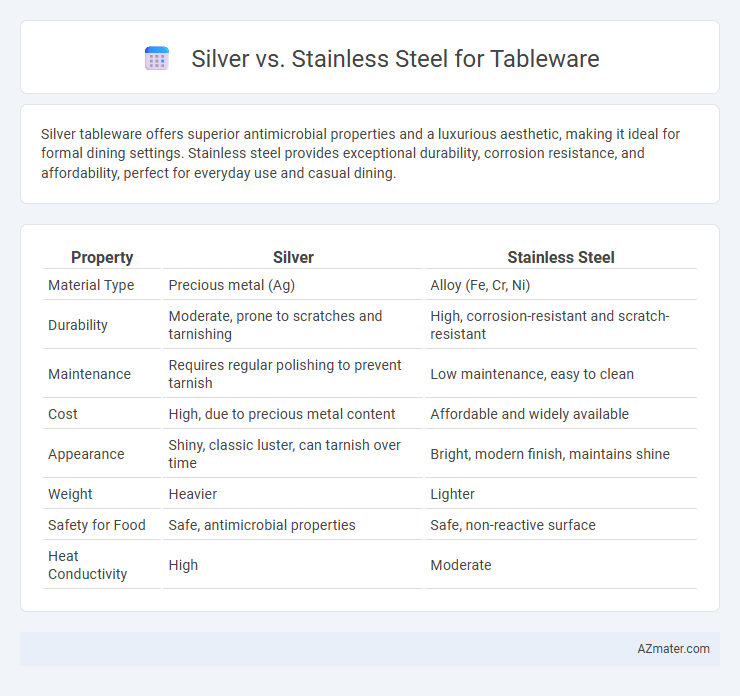Silver tableware offers superior antimicrobial properties and a luxurious aesthetic, making it ideal for formal dining settings. Stainless steel provides exceptional durability, corrosion resistance, and affordability, perfect for everyday use and casual dining.
Table of Comparison
| Property | Silver | Stainless Steel |
|---|---|---|
| Material Type | Precious metal (Ag) | Alloy (Fe, Cr, Ni) |
| Durability | Moderate, prone to scratches and tarnishing | High, corrosion-resistant and scratch-resistant |
| Maintenance | Requires regular polishing to prevent tarnish | Low maintenance, easy to clean |
| Cost | High, due to precious metal content | Affordable and widely available |
| Appearance | Shiny, classic luster, can tarnish over time | Bright, modern finish, maintains shine |
| Weight | Heavier | Lighter |
| Safety for Food | Safe, antimicrobial properties | Safe, non-reactive surface |
| Heat Conductivity | High | Moderate |
Introduction to Silver and Stainless Steel Tableware
Silver tableware, prized for its elegant appearance and antimicrobial properties, has been a symbol of luxury and tradition for centuries. Stainless steel tableware offers exceptional durability and corrosion resistance, making it a practical choice for everyday use. Both materials exhibit distinct qualities in terms of weight, maintenance, and aesthetic appeal, influencing their suitability for various dining settings.
Historical Overview of Tableware Materials
Silver tableware has been prized since ancient civilizations like the Romans for its antimicrobial properties and luxurious appearance, symbolizing wealth and status. Stainless steel emerged in the early 20th century as a durable, corrosion-resistant alternative, quickly becoming popular for its affordability and practicality. Both materials reflect evolving technological advances and cultural preferences in dining traditions worldwide.
Material Composition and Properties
Silver tableware, primarily made from sterling silver containing 92.5% silver and 7.5% copper, offers excellent antimicrobial properties and a timeless aesthetic with natural resistance to corrosion. Stainless steel tableware, usually composed of iron alloyed with chromium (at least 10.5%), nickel, and molybdenum, provides superior durability, rust resistance, and low maintenance due to its passivation layer. The choice between silver and stainless steel hinges on factors like weight, cost, tarnish resistance, and desired finish, with stainless steel being more practical for everyday use and silver favored for formal settings.
Aesthetic Appeal: Silver vs Stainless Steel
Silver tableware exudes a timeless elegance with its lustrous, warm sheen that enhances formal dining settings and reflects ambient light beautifully. Stainless steel offers a sleek, modern aesthetic characterized by its polished, mirror-like finish that complements contemporary kitchens and casual dining. Both materials provide distinct visual impacts, with silver conveying luxury and tradition, while stainless steel emphasizes durability and minimalist style.
Durability and Longevity Comparison
Silver tableware offers timeless elegance but is relatively softer and prone to tarnishing, requiring regular polishing to maintain its appearance. Stainless steel tableware is highly durable, resistant to rust, corrosion, and scratches, making it ideal for everyday use and long-term longevity. The hardness and maintenance-free nature of stainless steel generally provide better practicality over time compared to silver.
Maintenance and Cleaning Requirements
Silver tableware requires gentle handwashing with mild soap and soft cloth to prevent tarnishing and frequent polishing using silver-specific products to maintain its shine. Stainless steel tableware offers superior durability with easy maintenance, as it is dishwasher safe and resistant to rust and staining without the need for polishing. Proper care for silver extends its aesthetic appeal, while stainless steel provides practical everyday usability with minimal cleaning effort.
Health and Safety Considerations
Silver tableware offers natural antimicrobial properties that can reduce bacterial contamination, making it a safer choice for health-conscious users. Stainless steel is highly durable, resistant to corrosion and rust, and does not leach harmful substances, ensuring food safety and longevity in kitchen use. Both materials are non-reactive with most foods, but stainless steel's nickel content may cause allergies in sensitive individuals, whereas silver typically poses fewer allergenic risks.
Cost and Investment Value
Silver tableware commands a higher initial cost due to the precious metal's intrinsic value and craftsmanship, often making it a significant investment. Stainless steel, favored for affordability and durability, offers negligible resale value and limited investment potential. Over time, silver can appreciate or retain value, making it a viable asset, whereas stainless steel primarily serves practical use without financial gain.
Environmental Impact and Sustainability
Silver tableware, while recyclable and highly durable, demands significant mining activities that contribute to habitat destruction and energy-intensive refining processes. Stainless steel, composed mainly of iron, chromium, and nickel, offers a more sustainable option due to its corrosion resistance, longevity, and recyclability with lower environmental tolls in production. Choosing stainless steel tableware supports reduced resource depletion and carbon emissions, promoting eco-friendly dining choices aligned with sustainability goals.
Choosing the Right Tableware for Your Needs
Silver tableware offers timeless elegance and excellent thermal conductivity, making it ideal for formal dining and special occasions, while stainless steel provides durability, corrosion resistance, and affordability for everyday use. Consider factors such as maintenance requirements, budget, and usage frequency; silver demands more care to prevent tarnishing, whereas stainless steel is low-maintenance and dishwasher-safe. Choosing the right tableware depends on balancing aesthetic appeal with practicality, ensuring the material aligns with your lifestyle and dining preferences.

Infographic: Silver vs Stainless Steel for Tableware
 azmater.com
azmater.com